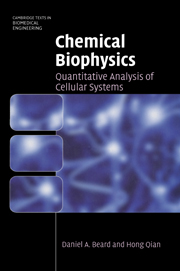Book contents
- Frontmatter
- Contents
- Preface
- Introduction
- Part I Background material
- Part II Analysis and modeling of biochemical systems
- 4 Enzyme-catalyzed reactions
- 5 Biochemical signaling modules
- 6 Biochemical reaction networks
- 7 Coupled biochemical systems and membrane transport
- Part III Special topics
- Bibliography
- Index
7 - Coupled biochemical systems and membrane transport
Published online by Cambridge University Press: 05 June 2012
- Frontmatter
- Contents
- Preface
- Introduction
- Part I Background material
- Part II Analysis and modeling of biochemical systems
- 4 Enzyme-catalyzed reactions
- 5 Biochemical signaling modules
- 6 Biochemical reaction networks
- 7 Coupled biochemical systems and membrane transport
- Part III Special topics
- Bibliography
- Index
Summary
Overview
As we have seen in previous chapters, living systems require that material be transported in and out in order to maintain an operating state (or operating states) that is far from thermodynamic equilibrium. Material is transported into and out of cells via passive permeation and by a diverse set of channels, pumps, transporters, and exchangers. In this chapter we consider kinetic models of transport across membranes, with specific examples of coupled transport and reaction in metabolic and electrophysiological systems. In the final example a computational model of oxidative ATP synthesis (which occurs as a set of reactions transporting charged species across the mitochondrial inner membrane) is developed. This model may be integrated with the detailed kinetic model of the TCA cycle presented in Chapter 6, allowing us to simulate and explore how the coupled systems interact – the TCA cycle producing reduced cofactors and the oxidative phosphorylation systems transducing the free energy of oxidation of these cofactors to synthesize and transport ATP.
Transporters
In Section 3.2 we introduced the basic processes of advection, diffusion, and drift, by which material is transported in biophysical systems. In this chapter we focus on a specialized class of transport: transport across biological membranes. Transport of a substance across a membrane may be driven by passive permeation, as described by Equation (3.60), or it may be facilitated by a carrier protein or transporter that is embedded in the membrane.
- Type
- Chapter
- Information
- Chemical BiophysicsQuantitative Analysis of Cellular Systems, pp. 162 - 192Publisher: Cambridge University PressPrint publication year: 2008



